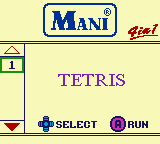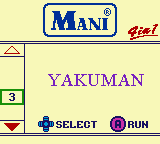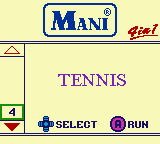To give a brief background, Nintendo had a small, but growing marketshare in Asia outside of Japan during the Game Boy era nd they decided to release a series of multicarts in China. The series is not very interesting except for Mani 4-in-1 that contains four 'classic' launch Game Boy titles: Tetris, Alleway, Yakuman and Tennis. The latter two games aren't the most exciting choice, but it is understandable why Nintendo selected the titles. Yakuman is a port of the classic Asian game Mah-jong. Tennis isn't great but it can provide a few minutes of ball rallying fun (sorry) on short bus trips.
The menu and the Super Game Boy enhancements are probably the most interesting aspect of the cart is the support for basic Super Game Boy functions (which I briefly wrote about on Twitter: https://twitter.com/nensondubois_/status/1127783157007364096 and here https://twitter.com/nensondubois_/status/1127792706233749509) depicting and matching the originally assigned palettes each game displays. Originally the games included would load a default palette accompanying the theme, area and setting of the game in question. The palette is selected based on the internal filename found within the game's header and then matched against the palette stored hash inside the Super Game Boy / 2 bios.
Instead of actually jumping to the game's bank as they later did with the GB Memory NP flash cartridge and resetting the Super Game Boy bios so it loads directly from memory, the developers took a different direction and instead matched the pre-defined palette as an equivalent Super Game Boy enhanced palette stored in the SNES WRAM. Was it lazier than writing a custom routine to jump to the game as mentioned prior? Possibly, but also not really; there is a technical reason why this method was chosen, but it is also contradictory and unrelated to how bankswitching actually works.
The general gist is using extra chips onboard either a cartridge or hardware interface, usually in the form of RAM and ROM to provide extra functions that native hardware was unable to allow. Tasks could include extra caching, additional sound capacities, better graphics (in older videogame systems including the Famicom and Master System, Turbo Grafx 16) and swapping out RAM and ROM and mapping it to original hardware locations gaining the benefit of better visuals, faster processing, and various other proprietary functions.While it is not technically the same as modern computer graphics cards and DDRAM work, the concept is reasonably comparable. Modern computer interchangeable hardware is rapidly increasingly becoming more complex weekly; the general idea is relatively the same.
Mostly likely the reason is because the developers were using discrete logic MMMC01 instead of the more complex custom flash setup the GB Memory worked with or utilised because it was cheaper and the games were only 32kb and the games didn't use MMCB3,05 battery backup for SRAM, or other special hardware and memory mapping chips, so the menu handles the jump to the game instead because it was easier and cheaper than designing a more robust system. It was probable that the Mani developers had the knowledge to write a custom routine using the Super Game Boy's DATA_SND and JUMP functions that were present in the GB Memory, but it was unnecessary. Still, it is interesting nonetheless. The game select menu even has two sets of palettes; one for loading and a secondary for when the menu fully transitions to its final area on screen. For reference, here is the main menu selection screen and the game's title screen with the default or enhanced Super Game Boy palettes designed to revolve around the game.
Writing the Mani 4-in-1 to a Game Boy flash cartridge like the GB Memory is also possible if you happen to have a flasher (more on building one yourself coming in a later article) device.
[CODE]
PAL_01
Tetris:015F4F0E639F15263100000000000000
Alleyway:01EF65BF7D5F03082100000000000000 Yakuman:01BC66FF3FE07E842C00000000000000 Tennis:016C2BFF7FD91C070000000000000000
[/CODE]
Finally, here is the game select menu using Super Game Boy Palettes. There are no Game Boy Color palettes.
In conclusion, the games play exactly the same as their retail counterparts and in case you're wondering, Tetris is 1.1 on the Mani 4-in-1 multicart. You question is most likely "Is it worth the money to track down a working cartridge?" Personally, I would since I am a game collector enthusiast of sorts so I managed to find a copy but for way more of a reasonable price. You mileage may vary.








No comments:
Post a Comment